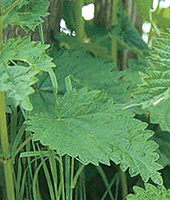Stinging Nettle
Sometimes I wonder how many people in today's society are seriously involved in making use of medicinal herbs, collecting them, drying them or making herbal juices.

If we had to pay doctors directly for every visit, or if hospital services were not covered under our Medicare plan, I am certain many would consider herbal medicine as an exceptionally inexpensive alternative. In fact, self-collected herbs are totally free, not costing even a penny!
While identifying individual herbs may pose some difficulty, stinging nettle is one of the most easily identifiable. The ragged leaves covered with fine, hair-like needles are characteristic only of stinging nettle. If you’ve ever touched this herb, you know the way it burns and itches for a long time, and that it takes days for the sensation to subside. The stinging is so bad, you wouldn’t wish it on your worst enemy!
Most people get burned accidentally while wandering through the woods. The stinging feeling on the skin surface left by the etheric oils of the fresh leaves is equal to an injection of formic acid. However, when you cut down the stinging nettle and let it wilt, after 30 minutes or so it doesn’t sting anymore. This is because the oils soon evaporate, which, in fact, illustrates well the change in composition of ingredients that every herb goes through during the drying process. For this reason, the freshly pressed juice of any herb, which captures the full spectrum of medicinal ingredients, is more effective than the dried herb.
Healing Uses
Believe it or not, in earlier times people beat their bare skin with bundles of fresh-picked stinging nettle to bring relief from rheumatic pains. Soldiers during the Second World War also found great relief from rheumatic pain, gout and skin impurities when stinging nettle tincture was applied as a poultice. Even today, the external use of freshly pressed nettle juice for relieving rheumatism is well known. Having passed the critical analysis of the 20th century pharmaceutical sciences with great honours, nettle’s stimulating effect on the kidneys and its resulting diuretic effects are medically proven.
One of the best known and acclaimed uses of natural, fresh pressed nettle juice is as a blood purifier. The experiments and tests of the well-known Swiss pharmacist Walther Schoenenberger have shown that nettle juice stimulates the metabolism by dissolving metabolic waste products (toxins) in the organs and-due to nettle’s strong diuretic properties–flushing them out of the system. Since both dissolving and flushing actions are most important for the purification of the blood, stinging nettle juice is the remedy par excellence for all complaints where toxicity and/or over-acidity of the blood are the source of the problem, including rheumatism and arthritis. Given its ability to dissolve and flush waste, nettle juice is also a
“natural” for weight reduction. As stinging nettle stimulates gland secretion, particularly of the digestive tract, various eczemas and acne can be cleared up by regularly drinking nettle herbal tea.
But let’s not forget the tonic and restorative properties of this wondrous medicinal “weed.” Because of nettle’s blood-building ability and high content of minerals such as iron, silica, calcium, magnesium and sulphur, it is recommended for treating anemia, degenerative diseases and symptoms of aging.
Nursing mothers can also be assured a sufficient quantity of milk by using nettle. The best, of course, is nettle juice, which can be bought in health food stores. Or, if you own a juicer (not the centrifugal type but the kind with twin gears, suitable for pressing juice from wheatgrass and herbs), you can press enough stinging nettle juice when in season and freeze it in special plastic freezer pouches. Then all you need to do is melt the frozen cube for fresh juice whenever you need it.
Selection and Preparation
Stinging nettle was one of the herbs in high demand during the Second World War. As school kids, we had to collect stinging nettle, which was widely used as the base for a number of medications. We were taught how to gather the lush green leaves of young plants and properly spread them out on paper for drying in the shady, lofty, warm attics under the roofs of our houses. This way we were guaranteed to get the best dark green looking, dried stinging nettle.
Stinging nettle grows everywhere in the moderate climate zones, especially near human habitation in areas where scrap metal has been discarded, such as behind barns and in dumps. Apparently a weed, the nettle family urtica, with about 60 species worldwide, nevertheless inflicts high demands on the soil. It requires considerable amounts of nitrogen and specific mineral content including silica and iron. Therefore, when making a herbal tea infusion,
take the desired amount of dried leaves and simmer them at medium temperature (about 70 C) on a stove top for 30 minutes, avoiding boiling. This way you will be assured to dissolve and activate most of the minerals. Being in colloidal form (absorbed in plant tissue), the minerals in nettle are highly bio-available.
If you choose to purchase nettle–and other herbs, for that matter–watch for good quality. When the leaves are faded or look brown, they indicate the herb was dried by the sun or even got wet from rain. Sun exposure and rain during the drying process lowers the quality. Also, never purchase herbs packaged in clear plastic bags, as light releases their essential oils to interact with the plastic, creating carcinogenic substances. Packaged herbs should always come in a paper bag inside a cardboard box, thereby avoiding the damaging influence of light.
Aside from these concerns, however, stinging nettle, both fresh-picked or dried and bottled is, based on my experience and generations of use, non-toxic to the body. No adverse indications have ever been reported in the relevant scientific literature.




